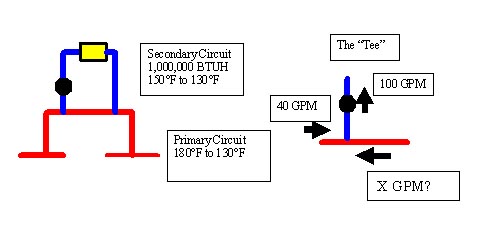Primary-Secondary Systems with Different DeltaT
| Condensing boilers become more efficient as the return water temperature becomes lower. To make the most of this investment in condensing boiler technology, the system return water temperature at design should be a low as possible. While designing for higher ΔT in the primary boiler loop there is, often times, a flow or temperature constraint in the secondary loop which limits the ΔT.
When the flow rate in the secondary system is less than the flow rate in the primary system remember the two tests described in the ITT Bell and Gossett Primary Secondary Manual; BTUH equality and the law of the tee.
Look at the example below and assume it is a 100% water system. If the secondary circuit requires 1,000,000 BTUH then the primary circuit must also provide 1,000,000 BTUH. Since BTUH=GPM X ΔT X 500 the secondary system flow rate must be 40 GPM. The secondary system requires a 20° ΔT and, therefore, requires 100 GPM at design.

The law of the tee requires the flow rate into the tee to equal the flow rate out of the tee. If there is 40 GPM of 180° water coming in from the primary and 100 GPM of 150° water leaving the tee into the secondary, there must be 60 GPM of return water coming back into the tee from the secondary system return. This return water is 130°.
These may appear to be simple rules to follow yet they provide a good check of the math when combining multiple primary secondary zones with varying supply temperatures. |
 |

Thank you for using products sold by R. L. Deppmann Company in Michigan and Ohio!
Disclaimer: R. L. Deppmann and it’s affiliates can not be held liable for issues caused by use of the information on this page. While the information comes from many years of experience and can be a valuable tool, it may not take into account special circumstances in your system and we therefore can not take responsibility for actions that result from this information. Please feel free to contact us if you do have any questions.
Archives – Click here for Past Articles



